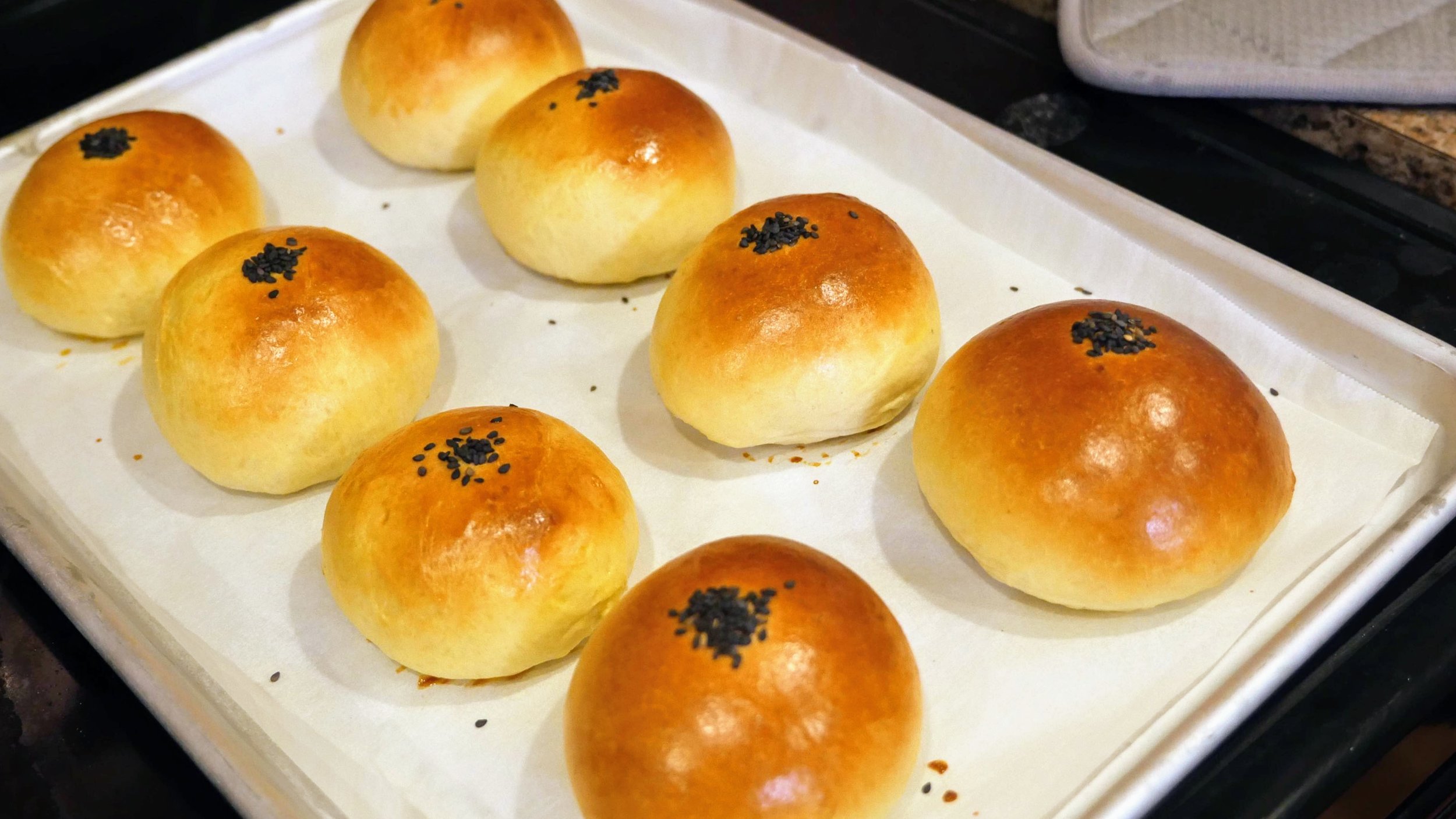Anpan (Japanese Sweet Red Bean Bun)

AWWgust has been home to some of the most adorable stuff to ever grace the Elliface channel. Why should Cooking With Heat be any different?
Anpan is one of the classic Japanese baked buns that you see at every bakery in Chinatown. Rich, sweet red bean paste inside, and fluffy, light bread on the outside. Simple, delicate pastry and straightforward flavor. Should be easy to make, right?
Aww Hell No
These little round bois are easily the most effort I've ever put into a dessert. The kneading, proofing, more kneading, pinching, twisting, proofing again... It's so much work for only 8 tasty little treats. But, if you like challenges that make very cute things and take 3+ hours plus a surplus of upper body strength, you should try to make these!
Anpan
Recipe found and adapted from justonecookbook.com. All process images are from justonecookbook.com (not my creation) however the recipe was tweaked slightly.
Pressure Cooker Anko (Red Bean Paste) Ingredients
300 g azuki beans
1200 ml water
300 g granulated sugar
pinch Kosher salt
Instructions
Instant Pot 7-In-1 Pressure Cooker
1. Put the 300 g azuki beans in a strainer and place it inside a large bowl. Rinse the azuki beans in running water until water is clear. Discard any pieces that are floating. Drain water.
2. Transfer the beans to the Instant Pot and add 1200 ml (about 5 cups) of water to your pressure cooker.
3. Cover and lock the lid of your pressure cooker. If you’re using an Instant Pot, turn it on and press the “Bean/Chili” button. Press the “minus” button to decrease the cooking time from the default 35-minute cooking time to 25 minutes.
4. Before you walk away, make sure the steam release handle points at “sealing” and not “venting”.
5. If you’re using a stove-top pressure cooker, cook on high heat until high pressure is reached. Then reduce the heat to low to maintain the pressure for about 20 minutes.
6. When it’s done cooking, the Instant Pot will switch automatically to “Keep Warm” mode. Let the pressure slowly release by itself for 15-20 minutes. If you are using a stove-top pressure cooker, remove the pot from the heat, and let the pressure release naturally. Before opening the lid, turn the steam release handle to vent and release any leftover pressure.
7. Scoop the foam on the surface and discard (if you prefer more refined taste).
8. Then drain the azuki beans through a fine sieve.
9. Put the azuki beans back in the Instant Pot and add the sugar. Press the “Saute” button and set for “Low” option.
10. Stir the azuki beans with a wooden spoon. When sugar has completely melted, add the salt. If you’re not using an Instant Pot, cook on medium low to medium heat.
When you can draw a line and see the bottom of the pot for 1 second, the mixture has thickened enough
11. Continue cooking until you can draw a line in the azuki bean mixture with the wooden spatula and see the bottom of the pot for 1 second. Then turn off the Instant Pot and take out the inner bowl from the Instant Pot and let the mixture cool for 5-10 minutes. The mixture will thicken more as it cools down.
12. Transfer the warm azuki beans into the food processor or blender. I use a 14 cup food processor so the mixture will all fit at once; otherwise blend in 2-3 smaller batches. If you prefer “proper” method, use a very fine mesh strainer and press the mixture with the wooden spoon. The azuki bean skins will be separated and you will get more refined koshian.
13. Run the food processor or blender until the mixture becomes smooth texture. If it’s too soft, don’t worry. It will dehydrate and become even more thicken till the paste is completely cooled.
14. Transfer to an airtight container. When it’s cooled and thickened more, it’s ready to use.
Anpan Ingredients
225 g bread flour
26 g cake flour
50 g granulated sugar
4 g kosher salt
3 g instant dry yeast
1 large egg
52 ml whole milk (room temperature)
50 ml water (room temperature)
37 g unsalted butter (cut into small cubes)
280 g sweet azuki red bean paste
Toppings:
1 large egg
1 Tbsp water
2 tsp black sesame seeds
Instructions
1. In a large bowl, combine 225 g bread flour, 25 g cake flour, 50 g granulated sugar, 4 g kosher salt, and 3 g dry yeast.
2. Beat 1 large egg in a small bowl and add to the bowl with dry ingredients.
3. Add 50 ml milk and 50 ml water.
4. Using your fingertips or a wooden spoon, gently mix the ingredients together until they are combined. In the beginning, dough is very sticky and wet, but keep mixing until it forms a loose, sticky ball. Also use the dough to pick up the flour on the sides of the mixing bowl. This step should take about 2 minutes.
5. Sprinkle a clean, stable surface with flour and transfer the dough from the bowl. Press the heels of your hands into the dough, pushing forward slightly. Fold the top half of the dough in half back toward you. Rock forward on the lower part of your palm to press it flat. Turn the dough slightly (to clockwise), fold it in half, and rock into it again with lower part of your palm. This process is called "punching" the dough and the goal is to lengthen and stretch the gluten strands in the dough. Repeat for 5 minutes or so. Tip: If the dough doesn't seem to be losing its stickiness, sprinkle more flour over the top and work it into the dough. You can lightly dust your hands with flour to keep the dough from sticking too much.
6. After “punching” for 5 minutes and the dough gets more elastic, press and stretch the dough for 10 inches. Then put small cubes of 35 g unsalted butter on top of the dough. Roll up the dough tucking the butter in, and then continue the kneading process.
7. As you knead, the dough will absorb the butter and it will eventually become very smooth and easier to work with.
8. When the dough becomes smooth, start banging the dough onto the counter and fold it over away from you. This helps develop gluten (elasticity). Bang the dough, turn it 90 degree, and “punch” it, using the lower part of your palm. Continue this process for 10 minutes or until the dough is smooth, supple, and silky. Tip: Don’t let go of the dough when you are banging onto the counter. Don’t let it rest for too long between turns.
9. Near the end, pull the end of your dough with your thumb and fingers. Keep spreading the dough with your fingers, stretching the dough into thin translucent membrane. This test is called Windowpane Test to see if the dough's gluten has been developed enough. Your dough is now ready to rise. If the dough tears, the gluten isn’t quite ready yet. Knead the dough for another 2 minutes and test again.
10. Shape the dough into a ball by pulling all sides of the ball to the bottom and pinching them together.
11. Place the dough in a bowl (the seam on the bottom) and cover with a plastic wrap. Let the dough rise in a warm place until the dough has doubled in size, about 1-2 hours.
12. Once the dough has doubled in size, dust your index finger with flour and put it in the center of the dough. If the hole doesn’t close, then the dough is ready for next step.
13. Press the dough with your hands to release gas in the dough and deflate.
14. Fold both sides of the dough toward center.
15. Then fold in thirds toward the middle. Flip, keeping the seam side on the bottom.
16. Shape the dough into a ball, rotating (clockwise) with both hands while the seam line is touching the work surface.
17. Using a dough scraper cut the dough into 8 equal pieces. If you need to adjust the size of dough, pinch off the center of the big dough and add to the center of the small dough and knead to combine well.
18. Shape each dough piece into a nice round ball, pulling from all the sides and tuck into the bottom. Place the dough on your left (right) palm, and rotate it with your right (left) hand, keeping the seam side on the bottom.
19. Put the dough on a baking sheet lined with parchment paper or silicone baking mat. Cover the dough with plastic wrap to prevent from drying. Rest the dough for 15 minutes at the room temperature.
20. After resting, flatten the dough with your hand, fold in thirds twice (just like you did earlier), and shape it into balls.
21. Press the dough so stretches to 3 inch diameter. Then put 35 g of red bean paste in the middle of the dough. Then pull all sides of the dough around and wrap the red bean paste tightly to seal.
22. Pinch the seam very well and put the seam on the bottom. Place the dough on your left (right) palm, and rotate it with your right (left) hand a few times, keeping the seam side on the bottom. Put the dough back into the baking sheet, seam side on the bottom.
23. Cover the dough with plastic wrap to prevent from drying. Let the dough rise in a warm place until the dough has doubled in size, about 30 minutes. When the dough has risen half way, preheat the oven to 400F.
24. In a small bowl, add 1 egg and 2 Tbsp. water and whisk very well. Using a pastry brush, brush all sides of the dough with an egg wash.
25. Sprinkle the black sesame seeds on top. I used a funnel to direct the sesame seeds to the center of the ball.
26. Bake at 400F for 13-15 minutes. Toward the end of baking if you see the bread is not being browning equally, rotate the bread once so that the bread gets equal color.
27. Once bread is baked, transfer to a wire rack and let it cool. Serve immediately or store in an airtight container or bag after it’s been cooled.













